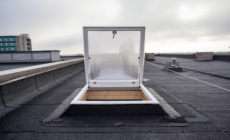-
Democrat Mocks CNN After Questioning Pay Raise for Congress - 25 mins ago
-
Attorney for Diddy accusers alleges Jay-Z’s team tried to turn his clients against him - 35 mins ago
-
Senate Clears Defense Bill Denying Transgender Care to Minors - 45 mins ago
-
Atmospheric River Update: Storm Could Hit 8 States on Christmas - 60 mins ago
-
Defense Bill Orders Military to Take New Action on Brain Injury - about 1 hour ago
-
Astros Predicted To Move Ryan Pressly In Shocking Blockbuster Trade - 2 hours ago
-
Woman Shocked by Mysterious Roof Door: ‘Horror Films Start That Way’ - 2 hours ago
-
‘Murder Hornet’ Has Been Eradicated From the U.S., Officials Say - 2 hours ago
-
L.A. County demands investigation into death of baby who died after being left in care of 11-year-old - 3 hours ago
-
Santa Tracker Live 2024: How to follow Mr. Claus with NORAD and Google this Christmas - 3 hours ago
Elevated radiation detected at former Bay Area landfill turned art park
State-ordered environmental testing has uncovered elevated levels of cancer-causing radiation at a popular spot for hikers and dog walkers in the Bay Area, according to a new report.
Over the summer, the city of Albany hired hazardous waste specialists with Cabrera Services Inc. to survey for the presence of radioactive waste at the Albany Bulb, a former municipal landfill for construction debris that now features scenic hiking trails and a sprawling collection of outdoor art.
State regulators ordered the investigation after discovering a 1980 archival document that suggested a former Richmond chemical plant dumped 11,000 tons of waste at the former Albany and Berkeley landfill from 1960 to 1971. The document indicated the waste may have included alum mud — a potentially radioactive sludge and byproduct of aluminum processing.
After surveying the city-owned portion of the peninsula, Cabrera Services found 10 areas with elevated levels of gamma radiation — powerful electromagnetic energy that can penetrate human tissue and damage cells.
Cabrera technicians are recommending that Albany conduct soil sampling in three places, where it determined alum mud or a radioactive object may be buried.
Nearly four decades after Albany’s municipal landfill closed, it has evolved into an outdoor art gallery filled with sculptures made from reclaimed wood, stone and metal. Although state regulators have deemed landfill materials as hazardous waste, it hasn’t deterred people from unearthing the refuse from the uncapped landfill and featuring it in eccentric pieces of art.
The new testing adds to the serious public health and safety concerns for one of the Bay Area’s most cherished coastal spaces. Gamma radiation is particularly concerning as this high-frequency energy can move through solid objects and human tissue, damaging DNA molecules and raising a person’s risk for cancer, according to Daniel Hirsch, retired director of environmental and nuclear policy at UC Santa Cruz.
“It’s like subatomic bullets being fired at the cells,” Hirsch said. “There is no safe level. Every level carries some risk.”
California Department of Public Health officials, however, said the initial gamma radiation observed at the Albany Bulb presented a “low level of risk to the public.”
“The survey results indicate that most of the site is consistent with normal background radiation levels, but 10 locations showed elevated readings,” a CDPH spokesperson said. “Our initial assessment shows that a person would have to spend approximately 20 hours on an elevated area to receive a dose equivalent to one dental X-ray.”

A colorful stone amphitheater is one of several art installations in the Albany Bulb.
(Paul Kuroda / For The Times)
The Cabrera Services report noted the radioactivity at the Albany Bulb is consistent with other landfills that accept construction debris, which may contain naturally radioactive material, such as granite. It remains unclear whether the levels of radiation are compatible for a publicly accessible space.
“The City doesn’t have enough information from the report to reach specific, final conclusions on ultimate public health risk,” said Brennen Brown, spokesperson for the city of Albany. “The next round of investigation will include soil sampling and shallow subsurface measurements that will help inform public risk levels. At this time, based on the information from the report, the City is not aware of any need to take additional actions to protect health and safety.”
Cabrera Services also said it’s “unlikely” the radioactivity is from large deposits of alum mud. Based on a review of historical documents, it said other parts of the man-made peninsula probably accepted this waste.
Cabrera staff highlighted adjacent tracts of land owned by the East Bay Regional Park District, which had previously been a privately owned landfill.
Cabrera staff and Albany city officials, however, did not immediately inform the East Bay Regional Park District. The Park District only learned about the findings and test results after a Times reporter reached out for comment.
Jordan Traverso, a spokesperson for the Park District, said regulators had not asked for them to test its property.
Meanwhile, the city of Berkeley is working toward examining its own survey for gamma radiation at Cesar Chavez Park, which was built atop the former municipal landfill. The city partnered with UC Berkeley Nuclear Engineering researchers to fly a drone survey over the 90-acre park and sweep small areas on foot, according to city spokesperson Seung Lee.
The test results, he said, will be released after researchers clean and analyze the data.
Source link
















